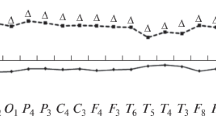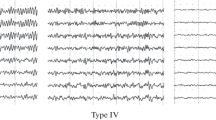Abstract
The absence of harmful effects of protracted negative air ionisation was studied in 5 weather-sensitive women and 5 normal men chosen at random. Negative ions were generated by the Modulion of Amcor-Amron (Herzliya, Israel). The patients were exposed separately during 8 sleeping hours and 8 working hours to the apparatus at 1–2 m distance in a 4 × 4 m room, for 2 months. Thus they were exposed to a daily uptake of 1 × 104 negative ions/cm3 for 16 h/day during 2 months. Urinary 17-KS, 17-OH, adrenaline and noradrenaline excretion was not affected by the negative ionisation. However serotonin, 5-HIAA, histamine and thyroxine excretion — if increased before — diminished by 50% on an average. There were no changes in body weight, blood pressure, pulse, respiratory rate, oral morning temperature, dynamometer grip strength, routine liver function tests, urinary pH, albumen, glucose, ketones, bilirubin, or occult blood, red and white blood count and ECG records. The EEG revealed the typical changes due to negative air ionisation: stabilising of frequency, increased amplitudes, spreading of brainwaves from the perceptive occipital area to the conceptive frontal area and synchronisation of both hemisphere tracings.
Similar content being viewed by others
References
ASSAEL, M., PFEIFER, Y., SULMAN, F. G., ALPERN, S. and SHALITA, B. (1974): Influence of artificial air ionisation on the human electroencephalogram. Int. J. Biometeor., 18: 3–6 312.
DANON, A. and SULMAN, F. G. (1969): Ionizing effect of winds of ill repute on serotonin metabolism. Biometeorology (Suppl. to Int. J. Biometeor.), Vol. 4, Pt. II: 135–136.
KNOLL, M., EICHMEIER, J. and SCHOEN, R. W. (1964): Properties, measurement and bioclimatic action of small multimolecular atmosphere ions. Adv. Electronics, Electron Physics. 19: 178–254.
KRUEGER, A. P. (1972): Are air ions biologically significant? A review of a controversial subject. Int. J. Biometeor., 16: 313–322.
MACFARLANE, P. S., DALGLIESH, C. E., DUTTON, R. W., LENNOX, B., NYHUS, L. W. and SMITH, A. N. (1956): Endocrine aspects of argentaffinoma and 5-HIAA determination. Scot. Med. J., 1: 148–155.
OATES, J. A., MARSH, E. and SJOERDSMA, A. (1962): Studies on histamine in human urine using a fluorometric method of assay. Clin. chim. Acta, 7: 488–497.
RIVOLIER, J. R., HARISSON, Y. and ZOULOUMIAN, P. (1975): Research on a possible action of negative overionization on healthy humans. Biometeorology, Vol. 6, H. E. Landsberg and S. W. Tromp (ed.), Suppl. Int. J. Biometeor. Vol. 19. Part 1, 134.
DE SCHAEPDRYVER, A. F. (1958): Differential fluorometric estimation of adrenaline and noradrenaline in urine. Arch. int. Pharmacodyn., 115: 223–245.
SULMAN, F. G. (1954): Routine micromethod for determination of urinary 17-ketosteroids. Acta endocr. (Kbh.), 15: 193–198.
SULMAN, F. G. (1974a): Meteorological front movements and human weather sensitivity. Karger Gazette, 30: 1–2.
SULMAN, F. G. (1974b): Foehnleiden, ihre Ursachen und Behandlung. Physik. Med. Rehabil., 15: 256–259.
SULMAN, F. G. (1976a): Health, Weather and Climate. Karger, Basel, 160 pp.
SULMAN, F. G., BAR-JOSEPH, M. and HIRSCHMANN, N. (1962): Routine method for determination of urinary 17-hydroxycorticoids and its application in different diseases and in heat stress. Israel Med. J., 21: 220–224.
SULMAN, F. G., LEVY, D. and LUNKAN, L. (1976): Wetterfühligkeit und ihre Beziehung zu Sferics, Ionen und Elektrofeldern. Z. physik. Med., 5: 229–238.
SULMAN, F. G., DANON, A., PFEIFER, Y., TAL, E. and WELLER, C. P. (1970): Urinalysis of patients suffering from climatic heat stress (Sharav). Int. J. Biometeor., 14: 45–53.
SULMAN, F. G., LEVY, D., LEWY, A., PFEIFER, Y., SUPERSTINE, E. and TAL, E. (1974): Air ionometry of hot, dry desert winds (Sharav) and treatment with air ions of weather-sensitive subjects. Int. J. Biometeor., 18: 313–318.
SULMAN, F. G., LEVY, D., PFEIFER, Y., SUPERSTINE, E. and TAL, E. (1975): Effect of the Sharav and Bora on urinary neurohormone excretion in 500 weather-sensitive females. Int. J. Biometeor., 19: 202–209.
TAL, E. and SULMAN, F. G. (1972): Urinary thyroxine test. Lancet, 1: 1291.
TAL, E., PFEIFER, Y. and SULMAN, F. G. (1976): Effect of ionization on blood serotonin in vitro. Experientia (Basel), 32: 326–327.
UDENFRIEND, S., WEISSBACH, H. and BRODIE, B. B. (1953): Assay of serotonin and selected metabolites, enzymes and drugs. In: Methods of Biochemical Analysis. D. Glick (ed.), Interscience Publ. N.Y., 6: 95–120.
Author information
Authors and Affiliations
Rights and permissions
About this article
Cite this article
Sulman, F.G., Levy, D., Lunkan, L. et al. Absence of harmful effects of protracted negative air ionisation. Int J Biometeorol 22, 53–58 (1978). https://doi.org/10.1007/BF01553140
Received:
Issue Date:
DOI: https://doi.org/10.1007/BF01553140




